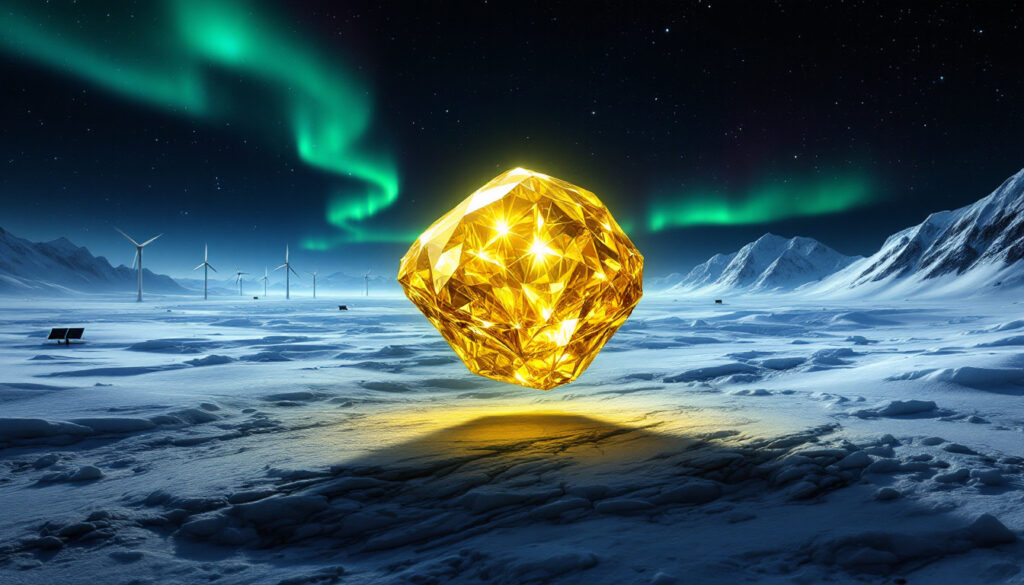What Makes This Diamond Discovery So Significant?
Rio Tinto's recent discovery at the Diavik Diamond Mine represents a remarkable achievement in the diamond mining industry. The 158.20-carat rough yellow diamond is among the largest gem-quality yellow diamonds ever discovered in Canada, making it a find of exceptional significance for both the company and the global diamond market.
The diamond's discovery represents a geological marvel that has defied tremendous odds. This stunning yellow diamond is approximately two billion years old, formed deep within the Earth's crust under extraordinary pressure and temperature conditions that are unique to the Canadian Shield's ancient geological formations.
"This discovery represents the culmination of advanced geological modeling and precise mining techniques," explains Dr. Sinead Kaufman, Chief Executive of Rio Tinto Minerals. "Yellow diamonds of this size and quality are extraordinarily rare, particularly in Canadian deposits, which makes this find all the more significant."
Historical Context of the Discovery
This exceptional yellow diamond stands as one of only five yellow diamonds weighing more than 100 carats ever unearthed at the Diavik operation throughout its 22-year operational history. To put this in perspective, yellow diamonds constitute less than one percent of Diavik's overall production, highlighting the extraordinary nature of this discovery.
What makes this find particularly noteworthy is that Diavik typically produces white gem-quality diamonds. The mine's kimberlite pipes, vertical geological structures that transport diamonds from deep within the Earth to the surface, rarely contain colored diamonds of this magnitude.
"The presence of nitrogen trapped within the diamond's carbon lattice is what gives this stone its magnificent yellow hue," notes Dr. James Thompson, a leading gemologist specializing in colored diamonds. "The concentration and distribution of nitrogen atoms must be perfect to achieve this intense yellow coloration."
Geological Significance
From a geological perspective, this diamond represents a perfect storm of favorable conditions. Approximately two billion years old, it formed during a period when the Canadian Shield was undergoing significant geological transformation. The yellow coloration results from nitrogen impurities incorporated during the crystal's formation process.
Industry analysts estimate that for every million carats of diamonds mined worldwide, fewer than 25 will be natural fancy yellow diamonds exceeding 100 carats. This places the Diavik discovery in an extraordinarily elite category, especially considering the mine primarily yields white diamonds.
The diamond's size and color classification suggest it may yield multiple cut stones of exceptional value, potentially including a centerpiece diamond of 30+ carats with intense yellow coloration that could command a premium of $30,000-$50,000 per carat at auction. Understanding mining drilling results helps appreciate just how remarkable this discovery truly is.
Where Is The Diavik Diamond Mine Located?
The Diavik Diamond Mine operates in one of the world's most challenging mining environments, situated in a remote and pristine region of Canada's Northwest Territories. This inhospitable location makes the mining operation—and by extension, this exceptional discovery—all the more impressive.
Geographic Location
Diavik is situated approximately 200km south of the Arctic Circle in the remote Northwest Territories of Canada. The mine is located on a 20-square-kilometer island in Lac de Gras, a pristine sub-Arctic lake. This remote location presents significant operational challenges, especially during winter months when temperatures can plummet to -50°C (-58°F).
The mine's geographic isolation necessitates extraordinary logistical planning. Most supplies and equipment must be transported via a winter ice road that's operational for only 8-10 weeks annually. During the remainder of the year, air transportation serves as the primary access method, highlighting the complex infrastructure required to support this operation.
"Operating in such a remote location requires exceptional planning and resilience," says Adam Burley, Managing Director of Rio Tinto's diamond operations. "Every aspect of the mine was designed to function self-sufficiently in an environment where the nearest major settlement is hundreds of kilometers away."
Operational Timeline
Diavik has been in continuous operation since 2003, representing over two decades of diamond production in one of the world's most challenging environments. Throughout its operational history, the mine has built a reputation for producing diamonds with what industry experts call "precious provenance and honorable pedigree"—meaning diamonds that are ethically sourced with full traceability.
The mine was originally a joint venture between Rio Tinto (60%) and Dominion Diamond Mines (40%), though Rio Tinto acquired full ownership in November 2021. This acquisition allowed Rio Tinto to implement its comprehensive sustainability strategy across the entire operation.
The mine's expected productive lifespan extends through 2025, making this yellow diamond discovery particularly significant as Diavik approaches the final stages of its operational life. Industry analysts note that exceptional discoveries often occur in the latter stages of mining operations as deeper sections of kimberlite pipes are accessed.
How Does Diavik Maintain Sustainable Mining Operations?
Rio Tinto has implemented significant sustainability measures at the Diavik mine, demonstrating a strong commitment to responsible resource extraction in this sensitive Arctic ecosystem. These initiatives represent industry-leading approaches to minimizing environmental impact while maximizing community benefits.
Renewable Energy Infrastructure
One of Diavik's most notable sustainability achievements is its hybrid wind-diesel power facility, which has been operational since 2012. This pioneering installation was the first large-scale wind farm at a remote mine site in northern Canada, consisting of four 2.3-megawatt turbines that generate approximately 10% of the mine's annual energy requirements.
Building on this success, Rio Tinto completed construction of a solar power plant at Diavik in early 2024, further reducing the operation's carbon footprint. The 4.5-megawatt solar array includes sophisticated tracking systems to maximize energy capture during the extended daylight hours of Arctic summers, when the sun barely sets.
"The integration of renewable energy at Diavik represents a significant technical achievement," explains Dr. Claire Martin, an environmental engineer specializing in remote industrial operations. "Operating a hybrid power system reliably in Arctic conditions requires innovative engineering solutions to address challenges like extreme cold, icing, and seasonal darkness."
Environmental Stewardship
Diavik operates as an off-grid facility, meaning it must generate all its own power while maintaining stringent environmental standards. The mine's environmental management system includes comprehensive water quality monitoring, waste management protocols, and wildlife protection measures designed to minimize impact on the surrounding ecosystem.
The mine employs an advanced water treatment facility that processes approximately 1.5 million cubic meters of water annually before release back into Lac de Gras. Water quality testing confirms that discharged water consistently meets or exceeds regulatory requirements for purity.
Rio Tinto has committed to a comprehensive mine closure plan that includes progressive reclamation throughout the operation's life. The company has allocated approximately $180 million for closure activities to ensure the site will be returned to a stable condition that supports native wildlife and vegetation after mining operations cease. This commitment to sustainability is part of Australia's clean energy revolution in mining, which is transforming the industry globally.
What Makes Yellow Diamonds Particularly Valuable?
Yellow diamonds represent a rare subset of diamond production with specific characteristics that make them highly sought after in the luxury jewelry market. Their distinctive color and scarcity command significant premiums compared to conventional white diamonds.
Rarity Factors
The exceptional yellow diamond discovered at Diavik belongs to a category known as "fancy yellow" diamonds in gemological terminology. These diamonds derive their color from nitrogen atoms that become trapped within the diamond's carbon lattice during formation—a process that requires specific geological conditions rarely found in nature.
At Diavik specifically, less than one percent of production yields yellow diamonds, with stones over 100 carats being exceedingly rare. This particular specimen's 158.20-carat size places it among the largest yellow diamonds ever discovered in Canada, and potentially in the top 50 largest rough yellow diamonds ever found globally.
"What makes this discovery particularly significant is the combination of size, color intensity, and geological origin," explains Sinead Kaufman of Rio Tinto. "Canadian diamonds are known for their exceptional quality and ethical sourcing, which adds a premium value dimension to an already rare stone."
Market Significance
In the diamond market, fancy yellow diamonds typically command prices 3-5 times higher than comparable white diamonds, depending on the intensity of color. The most valuable yellow diamonds display a rich, saturated "canary" yellow color without secondary hues.
Market analysts project that after cutting and polishing, this exceptional rough diamond could yield a principal stone of approximately 35-45 carats with potentially several smaller stones. Based on recent auction results for similar stones, the principal cut diamond could potentially fetch $30,000-$50,000 per carat if it achieves the coveted "fancy vivid yellow" color grade—potentially valuing just the centerpiece stone at over $1 million.
The timing of this discovery coincides with increasing market interest in colored diamonds as investment assets. Since 2005, fancy colored diamonds have appreciated approximately 12% annually, outperforming many traditional investment vehicles and making this discovery particularly significant from a market perspective. This trend has been noted by experts in mining investments, strategies, and geological insights as an important consideration for investors.
What Does This Discovery Mean For Rio Tinto?
This exceptional yellow diamond discovery has strategic importance for Rio Tinto's diamond business and overall market position as the company continues to develop its portfolio of premium diamond assets.
Business Impact
The discovery reinforces Rio Tinto's position in the premium diamond market at a critical time. With the planned closure of the Argyle mine in Western Australia in 2020—previously the world's largest producer of pink diamonds—Rio Tinto has been strategically repositioning its diamond business to focus on high-value production from its remaining operations.
"This remarkable yellow diamond demonstrates the continued productivity and exceptional potential of the Diavik resource," says Adam Burley, Managing Director of Rio Tinto's diamond operations. "As we approach the planned conclusion of mining at Diavik, discoveries of this caliber underscore the enduring value of this world-class asset."
The find showcases Rio Tinto's expertise in diamond extraction under challenging conditions and highlights the company's technical capabilities in identifying and recovering exceptional stones. Rio Tinto utilizes proprietary sorting technology that combines X-ray transmission, laser mapping, and optical recognition systems to identify valuable diamonds while minimizing damage during extraction.
Marketing Opportunities
From a marketing perspective, this discovery creates multiple opportunities for Rio Tinto. The company has previously leveraged exceptional diamond discoveries for targeted marketing campaigns that highlight the "beauty and purity" of Diavik diamonds, emphasizing their Canadian origin and responsible production methods.
Industry analysts suggest Rio Tinto has several options for monetizing this exceptional stone. These include: auctioning the rough diamond to specialized cutters; partnering with a luxury jeweler to create a signature piece or collection; or cutting and polishing the stone through Rio Tinto's own diamond division to maximize value capture across the supply chain.
"Exceptional discoveries like this create significant excitement among diamond enthusiasts and potential buyers, particularly in Asian markets where fancy colored diamonds have seen tremendous growth in demand," explains diamond market analyst Edahn Golan. "The provenance story of this diamond—formed billions of years ago in the Canadian Arctic—adds a compelling narrative dimension that resonates with luxury consumers."
The discovery also highlights the importance of digital transformation in mining operations, which has enabled more efficient identification and recovery of exceptional stones like this yellow diamond.
FAQ About Rio Tinto's Yellow Diamond Discovery
How rare are yellow diamonds from the Diavik mine?
Yellow diamonds represent less than one percent of Diavik's overall production, making them extremely rare, especially in sizes exceeding 100 carats. Industry data indicates that approximately 150,000 carats of diamonds are extracted from Diavik monthly, suggesting that yellow diamonds of any size represent fewer than 1,500 carats of monthly production, with specimens exceeding 100 carats appearing only a handful of times in the mine's two-decade history.
What makes this yellow diamond discovery exceptional?
At 158.20 carats, this rough diamond is one of only five yellow diamonds weighing more than 100 carats ever discovered at the Diavik mine in its 22-year history. The combination of size, color potential, and geological rarity places this discovery among the most significant Canadian diamond finds of the past decade. Gemological analysis suggests the stone has exceptional clarity characteristics that may allow for a principal cut diamond of remarkable size and quality.
How does Rio Tinto ensure sustainable diamond mining?
Rio Tinto employs renewable energy solutions at Diavik, including a hybrid wind-diesel power facility operating since 2012 that generates approximately 10% of the mine's power requirements and reduces diesel consumption by approximately 5 million liters annually. The company recently completed a 4.5-megawatt solar power plant that further reduces carbon emissions. Additionally, Rio Tinto implements comprehensive water management systems, progressive reclamation practices, and wildlife protection protocols to minimize environmental impact. These efforts align with broader ESG challenges and global opportunities in mining that are reshaping the industry.
Where exactly is the Diavik Diamond Mine located?
The Diavik Diamond Mine is situated on a 20-square-kilometer island in Lac de Gras, approximately 200km south of the Arctic Circle in the Northwest Territories of Canada. This remote location is approximately 300km northeast of Yellowknife, the territorial capital. The mine operates in a pristine sub-Arctic environment characterized by long, cold winters where temperatures can reach -50°C and short summers with nearly 24 hours of daylight. Access to the site is primarily via air transport, with additional supply deliveries occurring over a seasonal ice road operational for approximately 8-10 weeks each winter. You can see stunning images of the mine and the rare yellow diamond on Rio Tinto's official media channels.
Interested in Identifying the Next Major Diamond Discovery?
Discover how savvy investors capitalise on breaking exploration news with Discovery Alert's proprietary Discovery IQ model, delivering real-time notifications of significant ASX mineral findings before market momentum builds. Explore real examples of exceptional returns from historic discoveries at the Discovery Alert discoveries page and position yourself ahead of the market.




